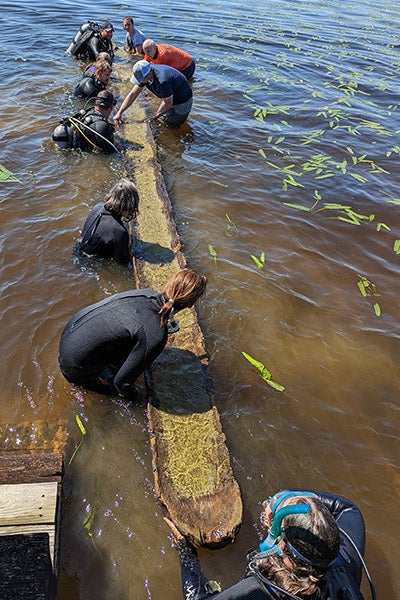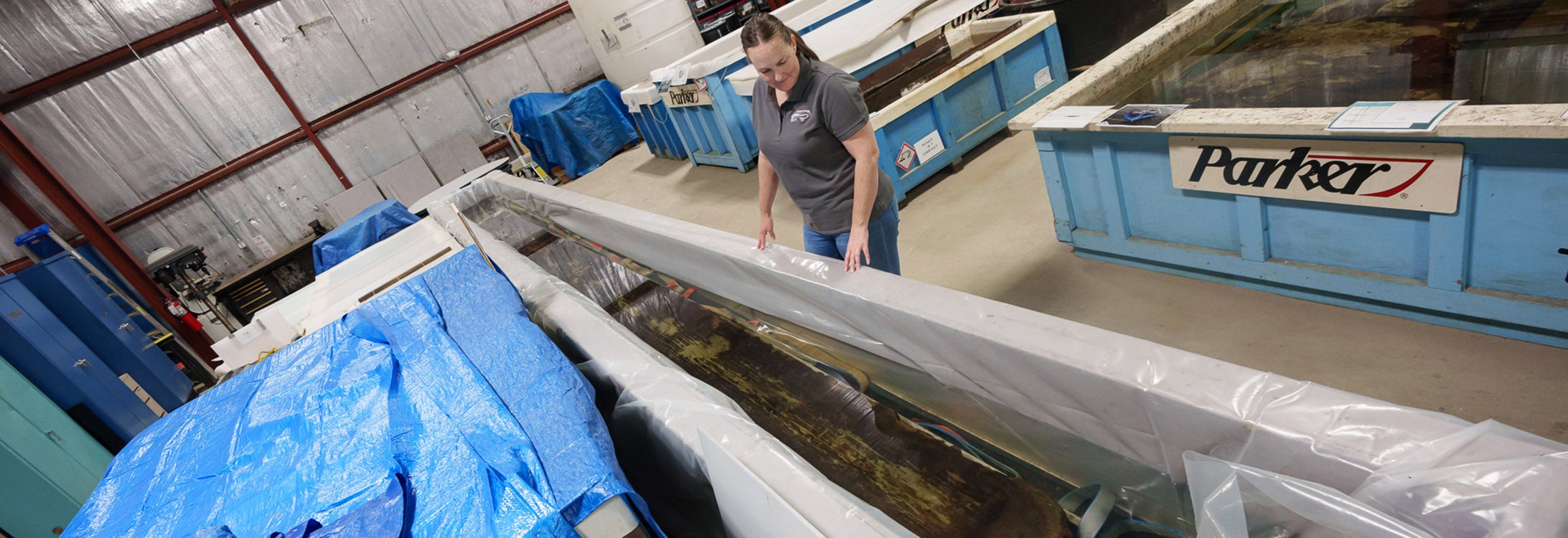EARLY NC ARTIFACT
QAR lab partners with Waccamaw Siouan Tribe to conserve 930-year-old canoe
The Queen Anne’s Revenge (QAR) Conservation Laboratory at East Carolina University’s West Research Campus is home to thousands of artifacts from the 300-year-old wreck of Blackbeard’s ship. Now it’s also home to an even older piece of North Carolina history — a Native American canoe discovered in Lake Waccamaw.
The canoe is about 30 feet long and about 930 years old, based on carbon-14 dating, said Kim Kenyon, lead conservator with the QAR lab. Made of a single tree, it is essentially a hollowed-out log. Native Americans in North Carolina would have used fire to fell the tree and to carve out the inside, Kenyon said.
“We find them in a lot of riverways and lakes in North Carolina,” she said. “They would have been used seasonally, just during the fishing season, and a lot of them were reburied, with some of them recovered in subsequent years so they could reuse them on the lake. But many were lost, abandoned, forgotten, only to be discovered years, or in this case a millenia, later.”
What makes this canoe unique is its condition.
View this video with closed captions on YouTube. ECU video by Bryan Edge.
“It is special to find one intact,” Kenyon said. “Many of the other canoes in North Carolina have only been parts and pieces. Some are older, some are more recent, but this is one of very few that are unbroken and fully intact from end to end.”
The canoe was discovered about two years ago by three kids playing in the lake. Upon finding the huge piece of wood partially buried in the lake bed, they reported it to one of their fathers.
“He realized that this piece of wood kept going as they kept digging, and he thankfully understood what needed to happen next,” said Kenyon. “He contacted our office, the Office of State Archaeology here in North Carolina. He also contacted the chief of the Waccamaw Siouan Tribe, Mike Jacobs, whose ancestral lands are around Lake Waccamaw.”

A team of divers and volunteers helped remove the canoe from Lake Waccamaw in April. (Photo courtesy of NCDNCR)
State archaeologists and tribal members converged on the lake to determine the best course of action. With the permission of the landowner, the canoe was stored underneath a dock until it could be safely recovered. That day came in April.
“On the lake that day, there were at least 100 people, mostly Waccamaw Siouan Tribe members who came to see this emerge from the lake. It was really a special day,” Kenyon said. “It’s a really remarkable find, to be so old and to have been in the lake for so long. It’s notable for us, who want to study it, and it’s certainly notable for those who see it as part of their cultural heritage.”
The Waccamaw Siouan Tribe has been instrumental in the recovery and conservation effort, Kenyon said, providing a flatbed truck that could safely transport the canoe to the QAR lab and building the tank in which it will remain submerged during the conservation process.
“That really came together logistically better than anyone expected,” she said. “(Jacobs) has been so supportive in rallying the community behind these efforts and getting everyone involved, because it is such a significant cultural find for a much broader part (of the population) than just archaeologists.”
The conservation techniques are similar to those used with artifacts from the Queen Anne’s Revenge, Kenyon said, but since the canoe is from a freshwater environment, there’s less salt to contend with, which should shorten the timeline somewhat.
“We’ll go through the process of desalinating it thoroughly and documenting it,” she said. “Waterlogged wood is damaged at a cellular level, and if we just let it dry out it would crumble into pieces, which obviously no one wants to see.
“So we’ll take the next few years to slowly impregnate it with a material called polyethylene glycol, a waxy substance that will help strengthen it at the microscopic level so that it can eventually be dried safely.”
It will be at least 5-7 years until that can happen, giving the team time to figure out where and how the artifact might be displayed and cared for. For now, the canoe will reside alongside the anchor, cannons and other artifacts of the Queen Anne’s Revenge at ECU’s West Research Campus.
The QAR Conservation Laboratory is operated by the N.C. Department of Cultural and Natural Resources on ECU’s West Research Campus in Greenville. It was dedicated in 2004 to conserve and document the artifacts from the wreck of Blackbeard’s flagship, the Queen Anne’s Revenge, discovered in 1996 near Beaufort Inlet.
